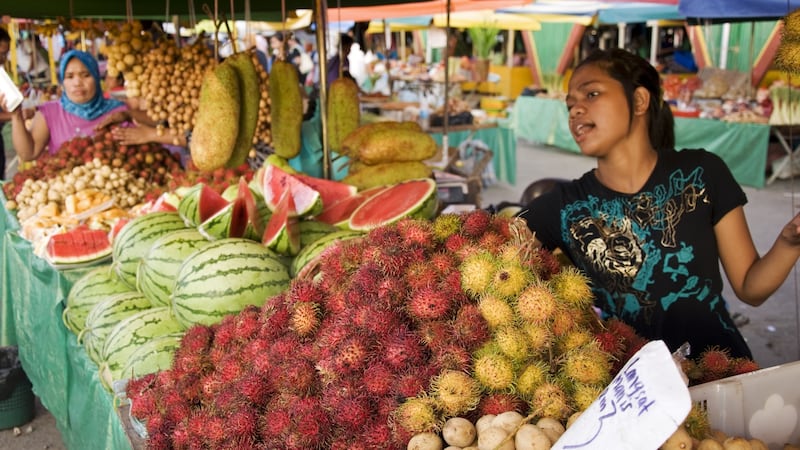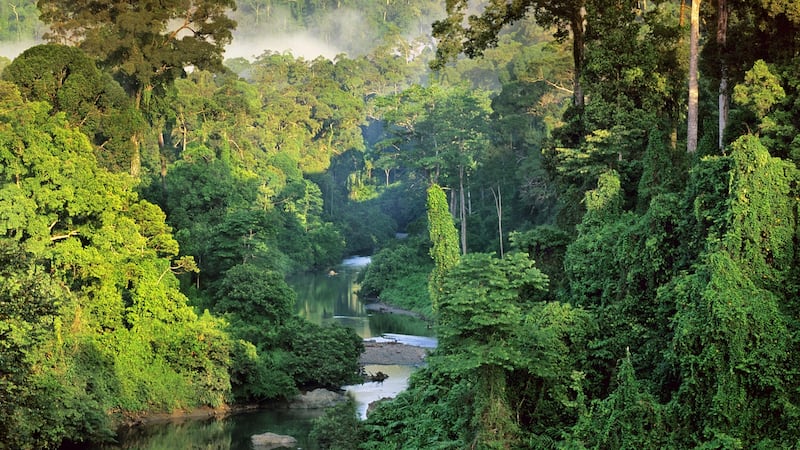Somewhere deep in the Bornean jungle a cicada emits a noise akin to an ambulance siren. It is shortly before 6am. The guides say the animal sounds off at this time every day, only put off his stride slightly if the weather affects his body-clock.
The fake siren is far from the only noise. The jungle is alive with a cacophony of sound, day and night. Metres from where we lie in our mosquito nets are pit vipers, huntsmen spiders, soldier ants, tiger leeches, lizards, bats and birds. Our hosts are members of the Murut tribe, former headhunters and the last local tribe to renounce the practice. We sleep on hard canvasses which creak loudly at each turn. This is not a trip for the faint-hearted.
But then you get up. You see the mist shrouding the jungle canopy ahead of you – it will burn off by 9am – and, for the moment the humidity is at the lowest it will be all day. The scents of breakfast – banana fritters and veggie noodles – waft from the kitchen. You look down upon the river and remember the joy of the children you saw diving yesterday as you travelled in low-slung boats towards camp. You forget about the disturbed sleep. The fear of the known unknown evaporates. Here you are, deep in the interior of Borneo, lost in the moment.


This is Sabah, one of the component states of Malaysia located in the northeastern part of what is the world's third-largest island (the territory is split between Malaysia, Brunei and Indonesia). Sabah is famed for its wildlife (orangutans and proboscis monkeys being its most famous residents), good diving off the east coast and climbing on Mount Kinabalu. The latter made international headlines earlier this year when a group of backpackers stripped off on the sacred mountain, an act which some locals claimed to have caused a magnitude 5.9 earthquake which killed 18 people.
But there is even more to this far flung territory, from the busy markets of Kota Kinabalu, snorkelling amidst the coral that surrounds the islands just north of the capital, the unspoiled beaches of the northern road to Kudat or a bit of luxury in five-star resorts that dot the coast. And, of course, jungle living.
After breakfast, which is delicious as all the jungle fare has been, we are transported in long boats upriver. Above us towers Batu Punggul, an imposing limestone formation which spikes – depending on who you ask – approximately 250m above the jungle floor.
We don’t know it yet but to get up there we have to do a free climb – with no harness. Our guide Virgil tells us the ascent is “70 per cent psychological, 30 per cent physical”. The trek to the base as the day’s heat rises is enough to make you think it impossible. The sheer rock cliff is imposing. But as we begin our ascent our guides’ expertise becomes apparent. Mine, who the younger locals address as “uncle”, speaks just two words of English: “here” as he points out where I should place my hands and feet and “okay?” to see if I am willing to go on.
Virgil acts as my safety harness, the absence of which you are very aware of when the sheer drop below your feet becomes evident. Using crags of rock, roots and vines we make it to the top and look down on the virgin rainforest and the brown, meandering river below with a sense of personal satisfaction.
Once we're back on solid ground there is time for a dip in the cool waters of the river below before a lunch of chicken curry, spicy grilled aubergine and freshly-cut watermelon. Afterwards we drift, half-floating half-swimming, downriver with the rainforest drapes over the river's edge on either side. The younger guides, in their late teens and early 20s, take to the water, trying to toss each other from their boat. The sun shines hot but the flowing water under the jungle canopy is refreshingly cold. It's hard to argue with the guidebooks description of this experience: "as Edenic as life gets".
When we’re too tired to swim anymore we get back into the boats and make our way back to the village from where Virgil collects us to bring us home; not back to our hotel but his father’s home, a modern “longhouse” which houses more than 30 other people.
The house is beautiful, the veranda overlooking the mist-laced jungle. Inside there is a huge entrance hall which will be our bedroom for the night. It is, we are told, Murut tradition for guests to sleep in the livingroom. In the corners stand vases of varying sizes which hold rice wine, the local speciality brew. Children of different ages scamper in and out of the great hall while the women of the house go about their business.
Richard Gunting, whose house we are staying in and whose tour company we are travelling with, greets us once he has returned home from his farm. He and his son have taken to growing cacao and sandalwood.
If successful they hope the “model farm” will be adapted by others in the area where there is little industry other than palm oil plantations and timber felling, industries which have taken their toll on the rainforest and, in turn, the wildlife which relies on it.
This is where the eco-tourism business also fits in. Its purpose is to safeguard the rainforest and to provide employment for local people while bolstering the local culture and teaching the people new skills – the huts in which we slept last night were built by local villagers under the tutelage of Filipino carpenters. What’s more, a portion of each tour fee goes towards a sponsorship fund to allow younger members of the tribe to attend university.
Next, it’s dinner time. Our meal, which includes baked tuna, wild boar, rice and a traditional tapioca pudding, is indeed a feast, all served by a multi-talented superwoman called Mamik.
The guests eat first, a tradition we observe even though we are not overly comfortable with our hosts waiting patiently for us to finish our food.
After the whole household has been fed it’s on to the entertainment. We are first given a sample of the local rice wine. The drinking of the local speciality is a sort of party game as we see how many notches each of us can muster from one of the large rice wine vases which fill the corners of the vast room.
Then the great hall becomes a stage: as members of the family – Mamik among them – play traditional gongs of varying sizes, the teenagers of the house troop out in the Murut’s traditional dress and perform the dances of their tribal ancestors.
It begins with four delicate pieces which see the girls, including six-year-old Barbara, twist their hands gracefully and the boys stamp manfully to the beat. Then, a step change. The last dance sees the introduction of lengths of thick bamboo which are crossed in a grid of Xs and Os.
With the bamboo the younger householders create a beat (the opening of which is exactly that of Queen's We Will Rock You). The dancers – Mamik is there again – at great risk to their ankles, spring in and out of the grid before the bamboos crack together. Following the performance we are inviting to join in (albeit at a much slower pace). The whole room cracks up at the sight of us. Well, with all they have done for us, it seems only fitting that we should reciprocate the entertainment.











